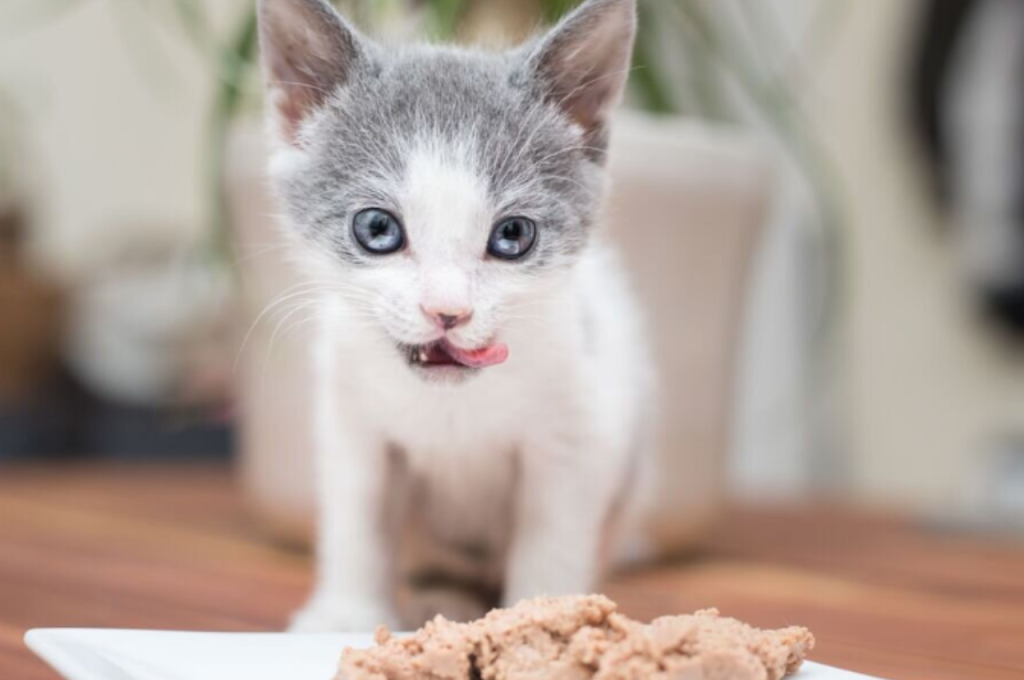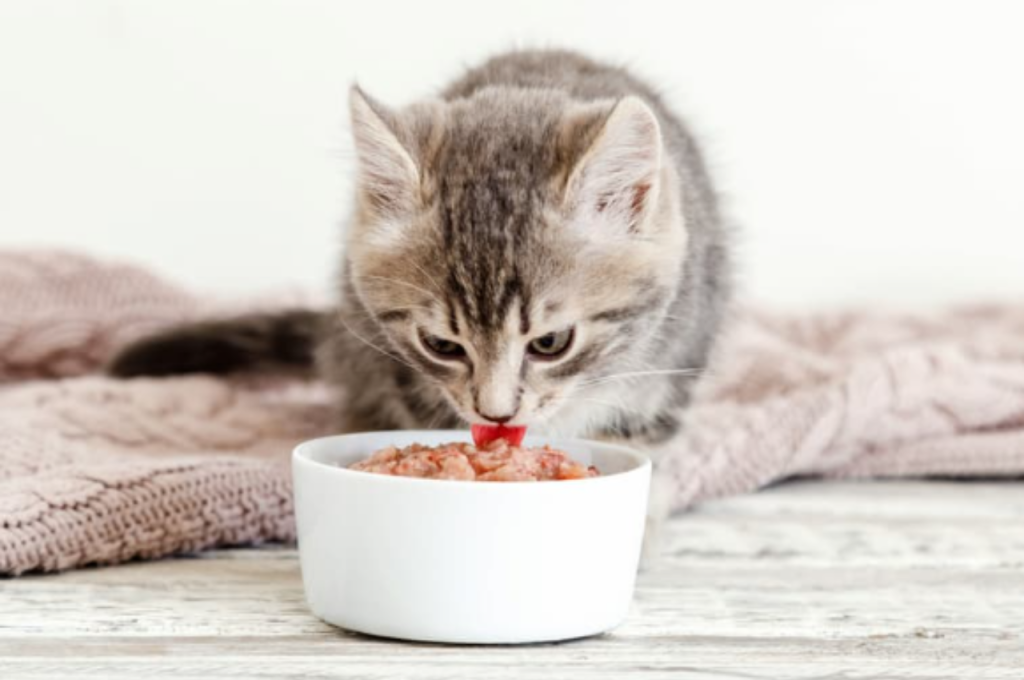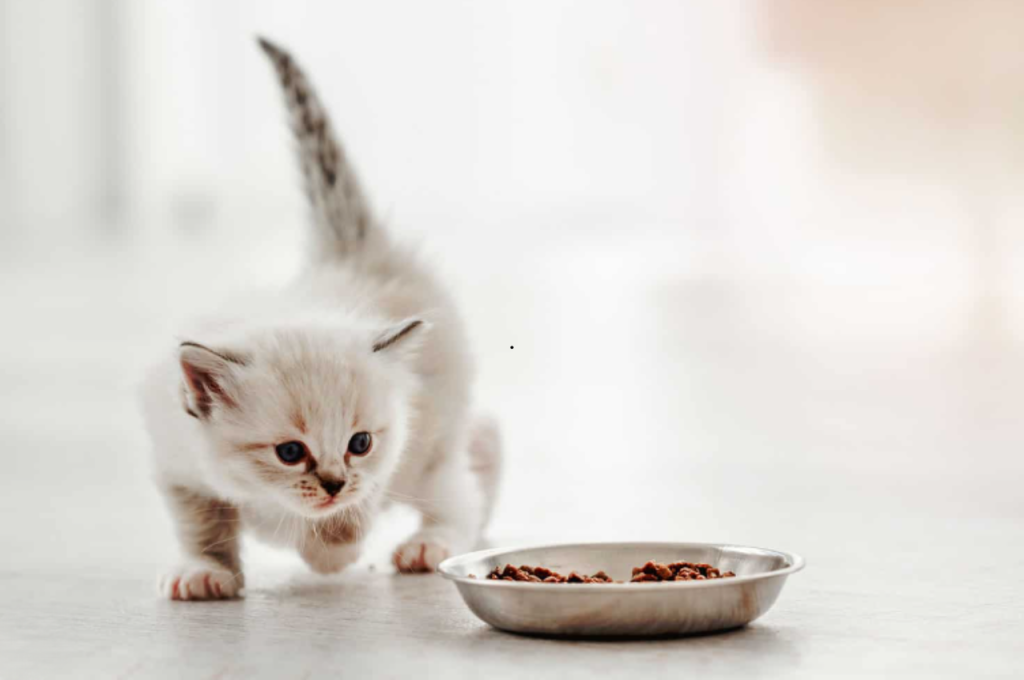To determine how much wet food to feed a kitten, offer 2-4 small meals daily, totaling 1/2 – 1 can. Introducing a new kitten to your home is an exciting time.
As a responsible pet owner, ensuring your kitten receives the right nutrition is crucial for their growth and development. One key aspect of caring for a kitten is providing them with the proper amount of food, especially when it comes to wet food. In this blog post, we will discuss how much-wet food to feed a kitten, the importance of a balanced diet, and tips for establishing a feeding routine that supports your kitten’s health and well-being. Let’s delve into the details of feeding your adorable new feline friend!
The Importance of Proper Nutrition for Kittens
Kittens are adorable little creatures that require proper nutrition for healthy growth and development. As a responsible pet owner, it’s crucial to ensure that your kitten is getting the right amount of nutrients to support their overall health and well-being. Feeding your kitten the appropriate amount of wet food is essential for their growth, development, and overall health.

Growth and Development
The first year of a kitten’s life is crucial for their growth and development. During this time, they require a balanced diet that is rich in protein, fat, vitamins, and minerals to support their growing bodies. Feeding your kitten the right amount of wet food can help ensure that they are getting the nutrients they need to thrive.
A kitten’s diet should consist of high-quality wet food that is specifically formulated for their age and size. Kittens require more protein than adult cats, as protein is essential for muscle growth and development. A diet that is deficient in protein can lead to stunted growth and development, which can have long-term health implications.
Health Implications of Over or Underfeeding
Overfeeding your kitten can lead to obesity, which can have serious health implications. Obesity in cats can lead to diabetes, heart disease, and joint problems, among other health issues. On the other hand, underfeeding your kitten can lead to malnourishment, which can also have long-term health implications.
It’s crucial to feed your kitten the appropriate amount of wet food to ensure that they are getting the nutrients they need without over or underfeeding them. Your kitten’s veterinarian can help you determine how much-wet food to feed your kitten based on their age, weight, and activity level.
Proper nutrition is essential for kittens to support their growth, development, and overall health. Feeding your kitten the appropriate amount of high-quality wet food can help ensure that they are getting the nutrients they need to thrive. Over or underfeeding your kitten can have serious health implications, so it’s crucial to consult with your kitten’s veterinarian to determine how much-wet food to feed them.
Wet Food Versus Dry Food for Kittens
When it comes to feeding your kitten, one of the decisions you’ll need to make is whether to feed wet food, dry food, or a combination of both. Wet food and dry food each have their own advantages and it’s important to consider the specific needs of your kitten when deciding which type of food to provide. In this section, we’ll explore the differences between wet food and dry food for kittens, and how these differences can impact your kitten’s nutritional needs and hydration.
Nutritional Content Comparison
When comparing wet food and dry food for kittens, it’s important to consider the nutritional content of each. Wet food typically contains higher moisture content, which can be beneficial for ensuring your kitten stays well-hydrated. Additionally, wet food tends to be higher in protein and lower in carbohydrates, which can be beneficial for a kitten’s growth and development. On the other hand, dry food is often more convenient and can be left out for free feeding without the risk of spoilage. However, it’s important to note that dry food may contain more fillers and preservatives, which can impact the overall nutritional quality.
Hydration Considerations
Hydration is a crucial aspect of a kitten’s overall health, and the type of food they consume can play a significant role in their hydration levels. Wet food can be an excellent way to ensure that your kitten receives an adequate amount of moisture, which is particularly important for kittens who may not drink enough water on their own. In contrast, kittens consuming primarily dry food may need to be monitored closely to ensure they are drinking enough water to stay properly hydrated.
Deciphering Kitten Food Labels
Deciphering kitten food labels can be confusing, especially when it comes to figuring out how much-wet food to feed your kitten. Look for labels that provide specific feeding instructions based on your kitten’s age and weight, and consult with your veterinarian to ensure your kitten is getting the appropriate nutrition.
Understanding Ingredients
When it comes to deciphering kitten food labels, understanding the ingredients is crucial. The ingredients listed on the label provide valuable information about the nutritional content of the food. By familiarizing yourself with common ingredients, you can make informed choices about the best-wet food for your kitten’s health. One key aspect of understanding ingredients is knowing that they are listed in descending order of weight.
This means that the first ingredient listed is the most abundant, while the last ingredient is the least present in the food. Look for high-quality protein sources like chicken, turkey, or fish as the first ingredient, as kittens require a diet rich in protein for proper growth and development. It’s also essential to be aware of any fillers or by-products present in the food. Fillers offer little nutritional value and can contribute to weight gain, so it’s best to opt for formulas without them.
By-products, on the other hand, can vary in quality and may not be as beneficial as whole meats. Keep an eye out for named by-products such as chicken by-product meal, which can provide more specific information about the ingredients’ origin.
Identifying Nutritional Adequacy
Another crucial aspect of deciphering kitten food labels is identifying the nutritional adequacy of the product. This information is typically found in a statement on the packaging, indicating whether the food meets the nutritional standards set by organizations like the Association of American Feed Control Officials (AAFCO). Look for phrases like “complete and balanced” or “formulated to meet the nutritional levels established by the AAFCO.”
These statements assure you that the food provides all the necessary nutrients your kitten needs for optimal health. They also indicate that the food has undergone feeding trials or meets the standards based on laboratory analysis. To further ensure the nutritional adequacy of the food, check for specific nutrient guarantees. These guarantees specify the minimum percentages of crude protein and crude fat, as well as the maximum percentages of crude fiber and moisture. These values help you assess whether the food meets your kitten’s specific dietary requirements. Deciphering kitten food labels is an essential skill for every cat owner.
By understanding the ingredients and identifying the nutritional adequacy of the food, you can make informed choices that promote your kitten’s health and well-being. Remember to prioritize high-quality protein sources and avoid fillers or by-products. With careful label reading, you can ensure your kitten receives the nutrition they need to thrive.
Determining The Right Amount of Wet Food
Feeding your kitten the appropriate amount of wet food is crucial for their growth and development. As a responsible pet owner, it is important to consider various factors such as age, weight, and activity level when determining the right amount of wet food to feed your kitten.

Age-specific Requirements
When it comes to feeding kittens, their age plays a significant role in determining their nutritional needs. As kittens grow, their dietary requirements change. Here’s a breakdown of age-specific requirements:
| Age | Recommended Daily Amount of Wet Food |
| 4-8 weeks | 3-4 small meals (about 1/4 cup each) |
| 8-12 weeks | 3-4 small meals (about 1/3 cup each) |
| 12-24 weeks | 3 meals (about 1/2 cup each) |
| 6-12 months | 2 meals (about 1/2 cup each) |
Weight and Activity Level Factors
Another crucial aspect in determining the right amount of wet food for your kitten is their weight and activity level. Kittens who are more active or have a higher weight may require more food, while less active kittens or those with a lower weight may require less. It is essential to monitor your kitten’s weight regularly and adjust their food intake accordingly.
Here are some general guidelines to consider:
- If your kitten is underweight or not gaining weight adequately, you may need to increase the amount of wet food gradually.
- If your kitten is overweight or becoming obese, reducing their food intake can help them maintain a healthy weight.
- Keep an eye on your kitten’s body condition and adjust their food portions accordingly to ensure they are neither too thin nor overweight.
Remember, these are general guidelines, and it is always recommended to consult with your veterinarian to determine the exact amount of wet food your kitten needs based on their unique circumstances. By considering your kitten’s age, weight, and activity level, you can ensure they receive the right amount of wet food for their optimal growth and overall well-being.
Feeding Frequency for Kittens
Kittens have high energy needs and require frequent meals throughout the day to support their growth and development.
Schedules for Different Growth Stages
- Kittens under 6 months old: Feed 3-4 meals a day, with a gradual shift to 2-3 meals as they approach adulthood.
- Kittens 6-12 months old: Transition to 2 meals a day to align with their mature feeding routine.
Free-feeding Vs. Timed-feeding Methods
- Free-Feeding: Leave food out all day, suitable for kittens prone to underfeeding or those with specific dietary requirements.
- Timed-Feeding: Offer meals at set times, aiding in monitoring food intake and establishing a feeding routine.
Transitioning From Milk to Solid Food
Transitioning a kitten from milk to solid food involves determining the appropriate amount of wet food to feed. Gradually increase the portion size to support their growth and development. Monitor their weight and adjust the feeding quantity as needed to ensure they are getting the right nutrition.
Weaning Process
Weaning a kitten from milk to solid food can be a challenging task. Generally, kittens begin weaning between four to six weeks of age. During this process, it is essential to provide them with a balanced diet that fulfills all their nutritional needs. The gradual transition from milk to solid food can take up to four weeks. During this time, kittens should be fed small portions of wet food multiple times a day. It is crucial to monitor their weight and ensure they are gaining weight at a healthy rate.
Introducing Wet Food
Introducing wet food to kittens is a crucial step in their development. Wet food is easier for kittens to digest and provides them with the necessary hydration they require. When selecting a wet food, it is essential to choose a high-quality brand that meets all their nutritional requirements. To introduce wet food, start by mixing a small amount of the food with formula or milk. Gradually increase the amount of wet food and decrease the amount of milk or formula until they are solely eating wet food. Kittens should be fed small portions throughout the day to ensure they are receiving all the necessary nutrients.
Feeding Amount
When it comes to feeding amounts, it is crucial to follow the guidelines provided by the food manufacturer. Generally, kittens should be fed three to four small portions of wet food per day. The amount of food given should be based on their age, weight, and activity level. It is important not to overfeed kittens as this can lead to obesity and health issues. Kittens should always have access to fresh water, and their feeding area should be kept clean and hygienic.
In conclusion, transitioning a kitten from milk to solid food can be a gradual process. It is essential to monitor their weight and provide them with a balanced diet that meets all their nutritional requirements. Introducing wet food is an important step in their development, and the feeding amount should be based on their age, weight, and activity level.
Common Feeding Mistakes to Avoid
When it comes to feeding a kitten, it’s crucial to avoid common mistakes that can impact their health and well-being. By being aware of these pitfalls, you can ensure that your furry friend receives the right amount of wet food to support their growth and development.
Overfeeding Risks
Overfeeding kittens can lead to obesity and other health issues. It’s essential to follow the feeding guidelines provided by the manufacturer and consult with a veterinarian to determine the appropriate portion sizes based on your kitten’s age, weight, and activity level.
Inadequate Diet Variations
Feeding your kitten the same wet food every day can result in nutritional deficiencies. To provide a balanced diet, incorporate variations such as different protein sources and flavors. This helps prevent boredom and ensures that your kitten receives a wide range of essential nutrients.
Monitoring Your Kitten’s Health and Diet
Monitoring your kitten’s health and diet is crucial for ensuring they receive the right amount of wet food. By paying close attention to their nutrition and overall well-being, you can help them grow into healthy and happy adult cats.

Recognizing Signs of Good Nutrition
Recognizing signs of good nutrition in your kitten involves observing their energy levels, coat condition, and overall body condition. A well-nourished kitten will have a shiny coat, playful demeanor, and maintain a healthy weight. Additionally, their stools should be firm and odor-free.
When to Consult a Veterinarian
If your kitten shows signs of poor nutrition, such as lethargy, dull coat, or weight loss, it’s important to consult a veterinarian promptly. Other concerning signs include vomiting, diarrhea, and lack of appetite. Early intervention can prevent more serious health issues from developing.
Conclusion
Feeding a kitten the right amount of wet food is crucial for its growth and development. By following the recommended guidelines and monitoring their weight, you can ensure that your kitten receives the necessary nutrients without overfeeding. Remember to consult with a veterinarian for personalized advice.
